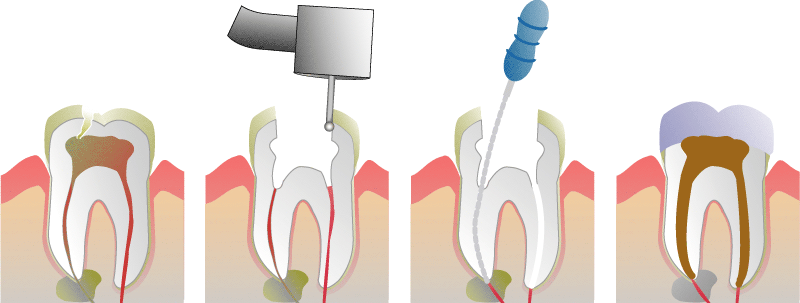
Root Canal Services
A root canal is the space within the root of a tooth. It is part of a naturally occurring space within a tooth that consists of the pulp chamber, the main canal(s), and more intricate anatomical branches that may connect the root canals to each other or to the surface of the root.
Advantages of Root Canal Treatment
Root canal treatment saves teeth that would otherwise have been extracted.
After root canal treatment, the tooth is pulpless - it has no vital tissues within. However, there are vital tissues surrounding the root (e.g. the gum, periodontal membrane and supporting bone).
A root-canal-treated tooth can function normally and can be maintained with routine dental care and oral hygiene measures.
What is Root Canal Treatment?
Removal of the infected or inflamed pulp is the first step in saving the tooth. Under local anesthetic, an opening is made in the crown of the tooth to get access to the infected or inflamed pulp within.
Using small, specially designed hard or rotary files, the root canals are cleaned and shaped to a form that can be sealed. Debris with the canal is removed by flushing with an anti-bacterial solution.
The canals are finally filled or sealed with an inert material called gutta-percha. The tooth should be restored to full shape and function by either a permanent filling or a crown, depending on how much of the tooth is left. This should be done as soon as possible as there could be a risk of tooth fracture due to biting forces.
All root canal treatment procedures are done by isolating the tooth with a rubber dam to provide a clean and saliva-free environment. Root canal treatment may be done in single or multiple visits depending on tooth complexity. In between treatment appointments, medicament may be placed within the canals and the tooth is covered with a temporart filling.
Often, X-rays are taken to determine the length of the root and to monitor the various treatment stages.
Is Root Canal Treatment Painful?
Root canal treatment procedures are relatively comfortable and often painless as the tooth is anaesthetised during treatment. After treatment, the tooth may be sensitive or tender for a few days due to inflammation of the surrounding tissues. This discomfort can be relieved by taking mild analgesics or painkillers available over the counter at the pharmacy.
However, if the pain persists, or gets worse (e.g. more intense; swelling), you should contact your dentist as soon as possible.
What Should I Do After Treatment?
Try to avoid chewing or biting on the tooth being treated until you have it permanently restored with with either a filling or a crown. Excessive pressure at this stage may crack or fracture the tooth.
Therefore, it is very important to restore the tooth properly as soon as possible. Most endodontically-treated teeth last as long as natural teeth following permanent restoration.
Practise good oral hygiene, including brushing and flossing at all times as root-filled teeth are as prone to decay as natural teeth. It is also important to have your treated tooth reviewed regularly by your dentist.
If you would like further information, please contact us at 62350646 or request for an appointment here.
1 Grange Rd #10-01 Orchard Building
Singapore 239693
(Located opposite Cineleisure @ Orchard Road)
